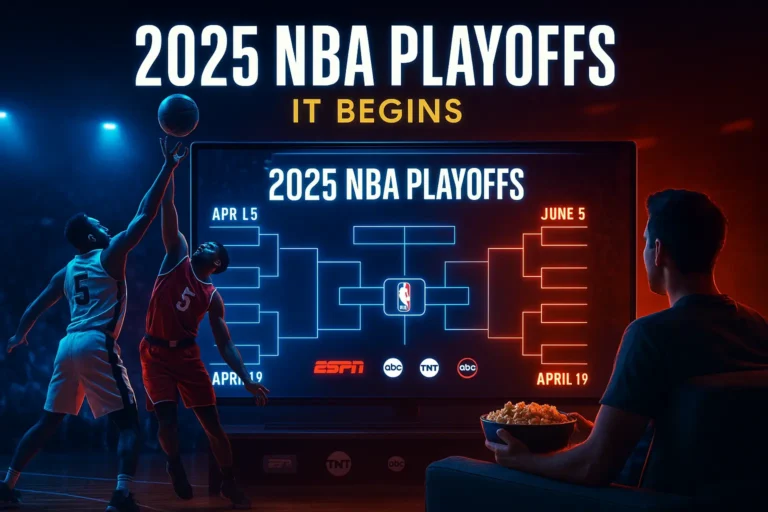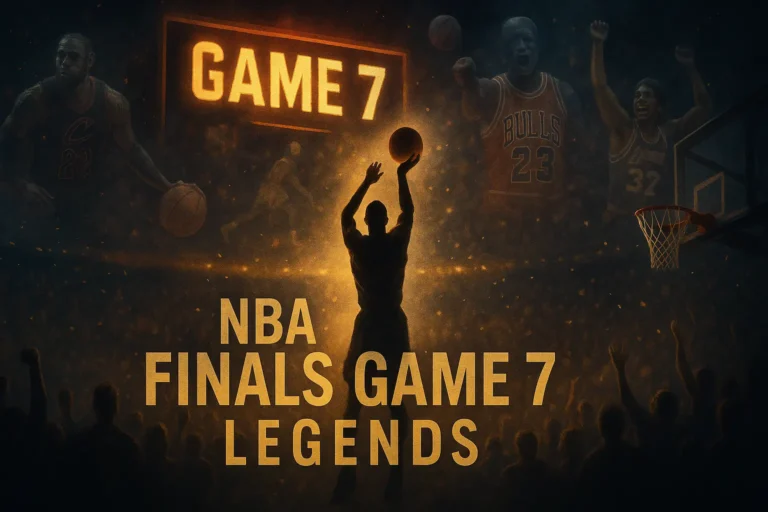NBA Playoffs vs Finals: Key Differences Explained (2025 Guide)
Introduction: NBA Postseason Basketball
The NBA postseason delivers basketball’s most intense competition, but its multi-stage format often confuses newcomers. Between play-in games, conference brackets, and the championship finale, even casual fans struggle to track the journey to the Larry O’Brien Trophy. This guide clarifies every step from opening tip to final buzzer.
Why the NBA Playoff Structure Confuses New Fans
Modern NBA playoffs combine traditional brackets with recent innovations like the play-in tournament. What began as a simple knockout tournament in 1947 now features four distinct rounds plus qualifying games. This evolution creates a steep learning curve for those new to basketball.
The terminology adds another layer of complexity. Phrases like “conference finals” and “NBA Finals” sound similar but represent very different stages. Understanding these distinctions transforms casual viewers into informed fans.
What This Guide Will Cover
We’ll demystify the entire postseason structure, from play-in games to trophy presentation. You’ll learn how teams qualify, how series work, and why playoff basketball feels radically different from the regular season.
The guide also explores strategic nuances, historical context, and what makes the Finals unique. Whether you’re a first-time viewer or longtime fan, you’ll gain fresh insights into basketball’s ultimate test.
Quick Answer: Playoffs vs Finals in 30 Seconds
The NBA Playoffs are a 16-team elimination tournament spanning four rounds. The NBA Finals is the championship series between Eastern and Western Conference winners.
Think of the playoffs as a marathon and the Finals as the final sprint. All playoff teams compete for conference titles, but only two reach the ultimate showdown.
1. NBA Playoffs vs Finals: Core Differences
Definition of NBA Playoffs
The NBA Playoffs feature the league’s top 16 teams (eight per conference) in a best-of-seven elimination tournament. Since 2021, this includes six automatic qualifiers and two play-in winners from each conference.
Teams battle through four grueling rounds: First Round, Conference Semifinals, Conference Finals, and ultimately the NBA Finals. Each series tests stamina, strategy, and adaptability.
Definition of NBA Finals
The NBA Finals represents the championship series between Eastern and Western Conference champions. This best-of-seven clash crowns the league’s ultimate winner and awards the Larry O’Brien Trophy.
Unlike earlier playoff rounds, the Finals guarantees basketball immortality. Winners earn championship rings, permanent roster notation, and a place in NBA lore.
Key Structural Differences
While both use best-of-seven formats, their scope and impact differ dramatically. The playoffs narrow the field from 16 to 2, while the Finals determines the single champion.
Number of teams involved
The playoffs begin with 16 organizations dreaming of glory. By the Finals, only two elite teams remain standing after eliminating all conference rivals.
Series format variations
All series follow a 2-2-1-1-1 home/away format, but Finals games feature extended breaks. This allows for deeper strategic adjustments between contests.
Championship implications
Playoff victories bring conference titles and temporary glory. Only Finals wins deliver permanent “NBA Champion” status and the sport’s highest honors.
2. The Complete NBA Playoff Structure
2025 Play-In Tournament Explained
The play-in tournament, now a permanent fixture, determines the final two playoff seeds in each conference. Teams ranked 7-10 compete in a three-game knockout format over four thrilling days.
The 7th and 8th seeds get two chances to qualify, while 9th and 10th seeds face elimination games. This creates must-win drama before the official playoffs begin.
First Round (Conference Quarterfinals)
Eight matchups (four per conference) launch the official playoffs. Higher seeds enjoy home-court advantage, hosting Games 1, 2, 5, and 7 if necessary.
First-round upsets occur frequently, proving regular season records don’t guarantee playoff success. Underdogs often thrive in these initial best-of-seven battles.
Conference Semifinals
Surviving teams face stiffer competition in the second round. Matchups follow fixed brackets without reseeding, preserving potential rivalries.
This round separates contenders from pretenders. Teams revealing weaknesses here rarely recover against elite opponents.
Conference Finals
The last two teams in each conference battle for conference championships and Finals berths. These series often feature legacy-defining performances.
Winners raise conference championship banners, but the ultimate prize still awaits. Conference titles represent milestones, not final destinations.
3. The NBA Finals: Championship Showdown
Finals Qualification Process
Reaching the Finals requires surviving three playoff rounds (12-14 wins). Teams must overcome varied opponents and adapt to different styles.
The journey eliminates flawed teams, ensuring only complete rosters with depth and resilience advance. Fatigue becomes a factor after two months of intense play.
Best-of-Seven Series Format
The Finals uses the standard 2-2-1-1-1 format but with heightened scrutiny. Every possession carries championship implications under basketball’s brightest lights.
Series often hinge on road victories. Since 1985, teams winning Game 5 on the road have claimed 17 of 20 championships when the series was tied 2-2.
Historical Context and Prestige
First held in 1947 as the BAA Finals, this championship series has grown into a global event. Iconic performances here define careers more than any other stage.
Legends like Magic Johnson, Michael Jordan, and LeBron James cemented their status through legendary Finals moments. The pressure creates basketball’s purest drama.
2025 Finals Schedule and Location
The 2025 Finals tip off June 5 at the higher seed’s arena. Potential hosts include Denver, Boston, or Oklahoma City based on current standings.
ABC will broadcast all games nationally, with streaming available on ESPN+. If necessary, Game 7 would occur June 22 at the same location as Game 1.
4. Key Format Differences: Playoffs vs Finals
Number of Games Played
Playoff teams play 12-28 total games depending on series lengths. Finals participants typically log 15-19 games before the championship round.
The physical toll accumulates over two months. Depth becomes as crucial as star power in the Finals’ crucible.
Team Matchup Dynamics
Early playoff rounds often feature familiar conference foes. The Finals presents unique inter-conference matchups with limited recent history.
Coaches must quickly solve unfamiliar schemes. Teams that adjust fastest often hoist the trophy.
Media Coverage and Broadcast Differences
Early playoff games air across ESPN, TNT, and ABC. The Finals receive exclusive ABC coverage with unprecedented production resources.
Media scrutiny intensifies exponentially. Player interviews and press conferences triple during the championship series.
Prize Money and Championship Implications
The NBA’s $30 million playoff pool distributes bonuses for each round reached. Finals participants claim the largest shares.
Beyond financial rewards, Finals success boosts future earnings. Championship pedigree increases player market value significantly.
5. NBA Playoff Rules vs Regular Season
Game Format Changes
Playoff games eliminate back-to-backs and feature extended timeouts (150 seconds vs 100). The pace slows as teams prioritize execution over transition play.
Defensive intensity spikes noticeably. Teams willing to sacrifice bodies for loose balls often advance furthest.
Foul Calling and Physicality
Officials “let them play” more in playoffs, tolerating greater contact. This rewards defensive specialists and punishes foul-dependent scorers.
Stars must adjust to tighter defense. Those who thrive despite physical play separate themselves from regular season standouts.
Overtime and Challenge Rules
Overtime remains five minutes, but coaches strategize differently. Successful challenges earn an additional challenge, rewarding correct decisions.
Every call carries amplified importance. Missed assignments in crunch time often decide series.
Home Court Advantage Factors
Home teams win roughly 60% of playoff games. Crowd energy impacts referee decisions and opponent communication.
The Finals’ 2-2-1-1-1 format slightly neutralizes home court. Since 1985, road teams have won 38% of Finals games.
6. Historical Performance Differences
Statistical Variations: Regular Season vs Playoffs
Scoring averages drop 3-5 points in playoffs as defenses tighten. Three-point percentages typically decline while rebounding numbers increase.
Superstars see usage spikes while role players’ minutes often shrink. Playoff rotations frequently condense to 7-8 trusted contributors.
Player Performance Trends
Elite players maintain or improve production despite defensive attention. Secondary scorers often struggle against targeted gameplans.
Historical “playoff performers” like Kawhi Leonard and Dirk Nowitzki elevated their games when stakes peaked. Others see efficiency declines.
Why Playoff Basketball Feels Different
Facing the same opponent repeatedly allows for strategic depth unseen in regular season. Coaches make subtle adjustments game-to-game.
The stakes eliminate casual play. Every possession becomes a calculated battle rather than free-flowing exhibition.
Memorable Playoff vs Finals Moments
Playoffs produce classics like Damian Lillard’s wave-off three-pointer. Finals create immortality like Ray Allen’s corner three in Game 6.
Championship moments resonate historically. Non-Finals heroics, while spectacular, fade faster from collective memory.
7. 2025 NBA Playoff and Finals Schedule
Play-In Tournament Dates
The 2025 play-in runs April 15-18 immediately after the regular season. Four teams per conference fight for final playoff spots.
Winners advance to face top seeds while losers’ seasons end abruptly. The compressed format guarantees high-stakes drama.
Playoffs Start Date and Structure
First-round games begin April 20 with potential Game 7s around May 4. Subsequent rounds start as previous ones conclude.
The bracket progresses linearly without reseeding. Conference finals typically begin in late May after two-week intervals.
Projected Finals Timeline
Barring delays, the 2025 Finals will start June 5. The series could conclude June 19 (4 games) or extend to June 22 (7 games).
The NBA Draft follows about a week later, creating a seamless transition to offseason activities.
How to Watch in 2025
Early playoff games air across ESPN, TNT, and ABC. The Finals receive exclusive ABC coverage with streaming on ESPN+.
International viewers can access games through NBA League Pass or regional broadcast partners. All games stream live on the NBA app.
8. Common Misconceptions About NBA Postseason
“Playoffs and Finals Are the Same” Myth
Many casual fans use these terms interchangeably. The playoffs encompass all postseason rounds while the Finals is just the championship series.
All Finals teams complete the playoff gauntlet, but most playoff teams never reach the Finals. The distinction matters.
Understanding Conference Championships
Winning your conference doesn’t equal NBA supremacy. Many conference champions (like the 2016 Warriors) fell short in the Finals.
Conference titles represent major accomplishments but remain stepping stones to the ultimate prize.
Play-In Tournament Confusion
The play-in isn’t technically part of the playoffs—it’s a qualifying round. Results determine the 7th and 8th seeds but don’t count as playoff games.
Play-in stats don’t affect playoff records. The tournament simply sets the official playoff bracket.
Seeding Misunderstandings
Higher seeds don’t guarantee easier paths. Brackets are fixed, meaning top teams could meet before the Finals.
Conference imbalance sometimes creates tougher roads for superior teams. Seeding matters less than matchups.
9. Expert Tips for Enjoying NBA Postseason
How to Follow the Playoff Bracket
Print a bracket from NBA.com to track progress visually. Note how winners advance through fixed matchups.
Watch for potential conference finals previews in early rounds. Upsets can dramatically alter the playoff landscape.
Key Players to Watch in 2025
Two-way stars like Giannis Antetokounmpo and Jayson Tatum typically shine brightest. Watch for Nikola Jokic’s playoff mastery.
Veterans like Stephen Curry leverage experience while rising stars like Anthony Edwards seek breakout moments.
Betting Strategies for Playoffs vs Finals
Early rounds favor home underdogs and live betting. Finals wagers require deeper matchup analysis and prop bets.
Consider series prices over individual games. Player performance props gain value in later rounds.
Where to Find Advanced Statistics
NBA Advanced Stats tracks playoff-specific metrics like clutch performance. Basketball-Reference offers historical comparisons.
Focus on net rating, true shooting percentage, and defensive impact metrics. These predict success better than basic stats.
10. Frequently Asked Questions
Are playoffs and finals the same thing?
No. The playoffs include all postseason rounds (four per team). The Finals is just the championship series concluding the playoffs.
How many games are in each playoff round?
All rounds use best-of-seven formats requiring four wins. Series last 4-7 games depending on results.
What’s the difference between conference finals and NBA Finals?
Conference finals determine Eastern and Western champions. The NBA Finals pits these winners against each other for the title.
Do playoff stats count towards regular season records?
No. Playoff statistics are tracked separately and don’t affect regular season averages or records.
How does the play-in tournament affect the playoffs?
It determines the 7th and 8th seeds in each conference. Winners enter the official playoff bracket facing higher seeds.
Conclusion: Mastering NBA Postseason Knowledge
Understanding the NBA postseason’s structure transforms viewing from casual to expert level. From play-in drama to Finals glory, each stage offers unique strategic depth.
Armed with this knowledge, you’ll appreciate the 2025 playoffs like never before. Watch for how fatigue, matchups, and adjustments shape the journey to the Larry O’Brien Trophy.






